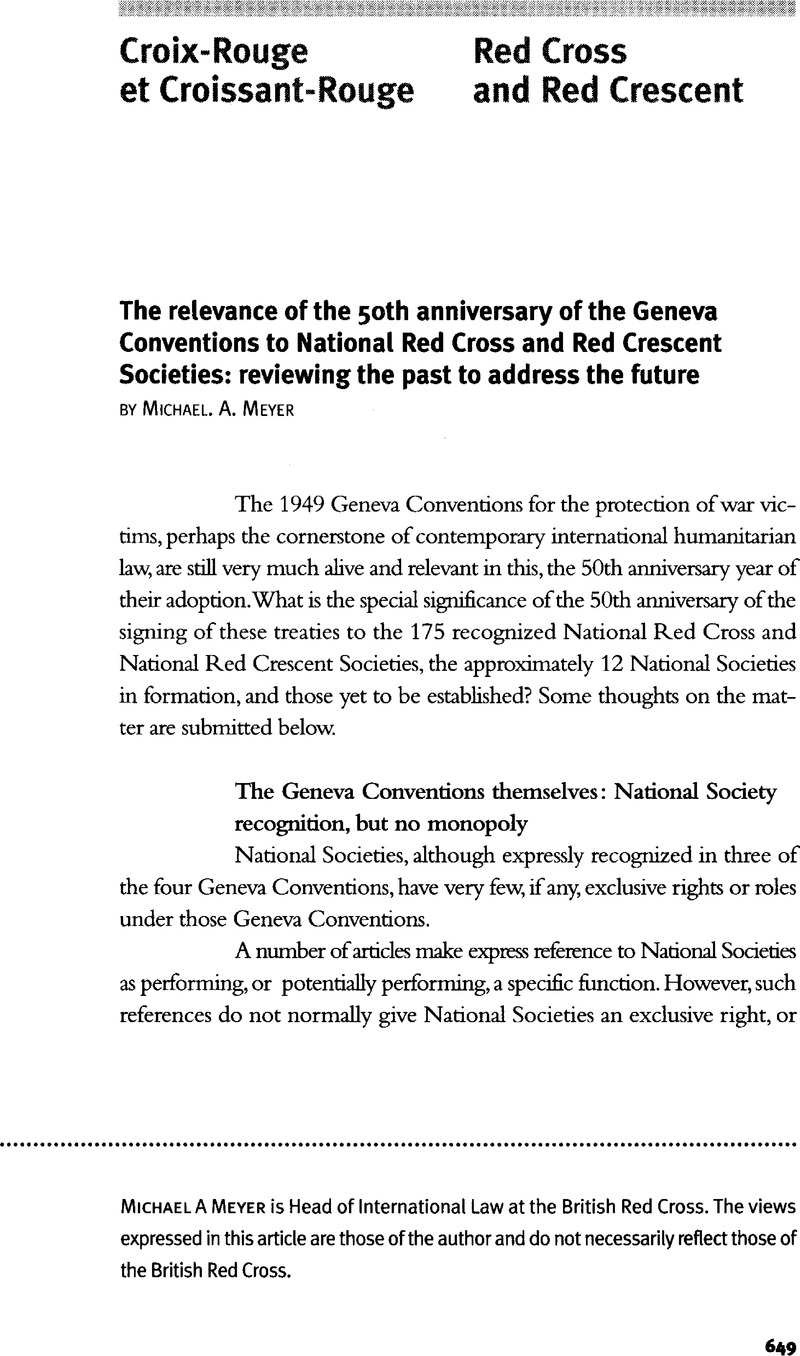No CrossRef data available.
Article contents
The relevance of the 50th anniversary of the Geneva Conventions to National Red Cross and Red Crescent Societies: reviewing the past to address the future
Published online by Cambridge University Press: 19 April 2010
Abstract

- Type
- Croix-Rouge et Croissant-Rouge/Red Cross and Red Crescent
- Information
- Copyright
- Copyright © International Committee of the Red Cross 1999
References
1 The same terminology is used in the two 1977 Protocols additional to the 1949 Geneva Conventions, namely Article 8(c)(ii) of Additional Protocol I and Article 18(1) of Additional Protocol II.
2 The international Red Cross and Red Crescent organizations are permitted to use the emblem at all times: First Geneva Convention, Article 44, para. 3.
3 The ICRC commentary says that this is “a drafting error, and is completely illogical”. Pictet, Jean S. (ed.), Commentary to the Convention for the Amelioration of the Condition of the Wounded and Sick in Armed Forces in the Field, ICRC, Geneva, 1952. p. 329Google Scholar. However, there may be organizations that used the name “Red Cross” or something similar before the adoption of the relevant Geneva Convention, and they may have a right under national law to continue to use their long-established name; but such organizations are rare.
4 These roles have also been recognized in Resolutions of the United Nations General Assembly, of the Diplomatic Conferences of 1949 and 1974–1977 and of various International Conferences of the Red Cross and Red Crescent.
5 Indeed, it may be their participation at the International Conference, that most distinguishes National Societies from other voluntary aid societies, rather than use of the emblem, association with the Geneva Conventions, or other characteristics.
6 UN General Assembly Resolution 49/2 of 19 October 1994.
7 Joint Committee for the Re-appraisal of the Role of the Red Cross, Red Cross at National Level: A Profile, p. 37, and Final Report: An Agenda for Red Cross, p. 97, Geneva, 1975.
8 Perruchoud, R., International Responsibilities of National Red Cross and Red Crescent Societies, Henry Dunant Institute, Geneva, 1982, pp. 67 and 91 respectivelyGoogle Scholar.
9 The ICRC's People on War project, which welcomes the support of National Societies, is another opportunity to promote international humanitarian law. More generally, the 27th International Conference of the Red Cross and Red Crescent (Geneva, 1999) offers an opportunity to reinforce the National Societies' role. For the experience of one National Society, see Meyer, M. A., “The role of a National Society in the implementation of international humanitarian law: Taking up the challenge!”, IRRC, No. 317, March-April 1997, pp. 203–207Google Scholar.
10 In 1998 the International Law Committee of the Danish Red Cross published the outlines of such a proposal: “Voluntary Review Procedure on National Implementation of International Humanitarian Law”. This proposal was noted by the 1997 Council of Delegates, a statutory body of the International Red Cross and Red Crescent Movement, and National Societies were invited to examine the proposal with their respective governments (Resolution 4, paras. 7 and 8).
11 The adaptability of the Geneva Conventions was shown during the South Atlantic conflict (1982). During that conflict, a “Red Cross Box” was established in the spirit of the Conventions to provide a protected zone for hospital ships, and Argentine prisoners of war were accommodated on vessels, rather than in camps on land, to provide them with better living conditions.


